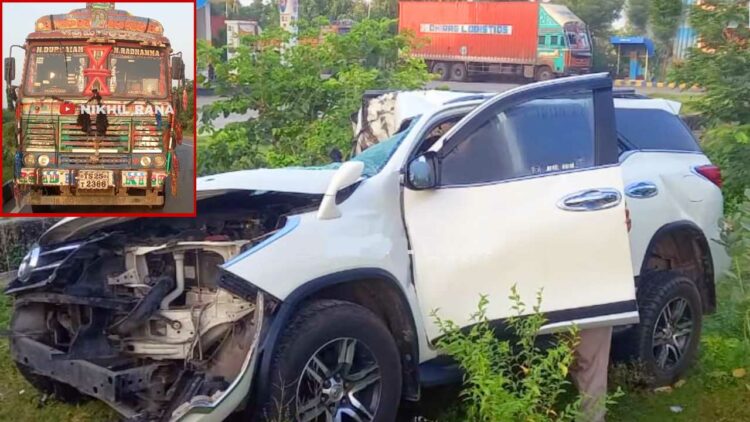A Toyota Fortuner recently collided with a truck at 140 km/h, thereby sustaining heavy damage. While the SUV kept all its occupants safe in this massive crash, it’s crucial to note that none of the airbags could deploy. This unfortunate incident recently took place in Telangana. Cruising at 140 km/h, the Fortuner crashed into the rear of the truck. The mishap took place due to sudden braking from the truck. Fortunately, the robust structure of the Fortuner kept all the occupants safe. However, the owner was left shocked with airbags failing to deploy The video we have embedded with this page will show you the aftermath of the accident.
You may also like: Toyota RAV4 Spotted Testing in India – What’s Happening?
Toyota Fortuner Keeps All Safe Despite Airbags Not Opening
It becomes important for me to mention here that all the occupants of the SUV were wearing seatbelts at the time of accident. Fortunately, there was no grave injury to anyone. That said, one of the occupants was taken to a hospital as he suffered some injuries. Unfortunately, there’s no image of the truck’s rear. The lack of visuals makes it tough for us to provide insights into the initial point of impact, crucial for airbag deployment. Airbags rely on precise sensors, and if the impact occurs beyond the expected zone, they might not activate. It’s totally possible that the truck lacked a crash bar, causing the first impact to be higher than the Fortuner’s bumper or bonnet. This often results in airbag non-deployment.
You may also like: Low Rider Versions of Toyota Hilux and Fortuner Look DOPE!
Unraveling the Mystery: Why Airbags Sometimes Don’t Deploy in Car Accidents
In car accidents, airbags play a crucial role in ensuring passenger safety. However, there are instances where these life-saving devices may not deploy as expected. Let’s delve into the reasons behind the occasional failure of airbags to open during an accident.
1. Impact Outside Expected Zones:
- Airbags are designed to deploy within specific impact zones.
- If the collision occurs outside these predefined areas, airbags may not activate.
2. Lack of Crash Bar on Other Vehicles:
- Vehicles without a crash bar may impact higher than the expected bumper level.
- This can result in the airbag sensors not detecting the crash effectively.
3. Sensor Malfunction:
- Airbags rely on sensors to detect the severity and type of impact.
- Malfunctioning sensors can lead to inaccurate readings, preventing airbag deployment.
4. Low-Speed Collisions:
- Airbags are typically designed to deploy during moderate to high-speed collisions.
- In low-speed accidents, the deployment threshold may not be met, keeping airbags inactive.
5. Outdated or Defective Airbag Systems:
- Older vehicles may have outdated airbag systems that lack advanced features.
- Defective components in the airbag system can hinder proper deployment.
6. Seatbelt Usage:
- Modern vehicles often have systems that consider seatbelt usage in airbag deployment.
- If occupants aren’t wearing seatbelts, the airbags may not deploy to prevent unnecessary injury.
7. Multiple Collisions:
- Some airbag systems are such that they deploy only in the first collision.
- In scenarios involving multiple impacts, subsequent collisions may not trigger airbag deployment.
8. Vehicle Orientation:
- The orientation of the vehicle post-collision can affect airbag deployment.
- In certain positions, airbags may not activate to avoid causing harm to occupants.
You may also like: Toyota Hyryder Buyer Claims Paying Rs 1 Lakh Extra for Early Delivery – VIDEO
Author’s Note
I have come across many car owners who blame airbags not deploying in accidents. However, understanding the intricacies of airbag deployment is crucial for comprehending why they may not open in certain accidents. Carmakers continually enhance airbag technology, but factors like impact zones, sensor accuracy, and collision dynamics contribute to the occasional non-deployment. Stay informed about your vehicle’s safety features to maximize protection in unforeseen circumstances.
You may also like: 5 Toyota Cars No One Bought – Prius to Yaris


